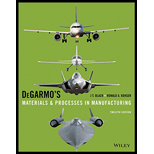
Why are the fabrication processes applied to plastics, ceramics, and composites often different from those applied to metals? What are some of the key differences?
The reason for difference in fabrication process of metal to plastics, ceramics, and composites.
Explanation of Solution
The fabrication processes that are applied to plastic, ceramics, and composited are quite different from the processes applied to metals because they had different structures and material properties compared to metals. Generally, the fabrication of these materials takes place at low temperatures compared to the fabrication of metal. Also, less time and money is required to fabricate those materials. In all, the strength of fabrication may be more than the strength of base material.
The key differences are that raw material can be turned into a finished product in only one process, large and complex shapes are formed as a single unit, joining, and fastening operations are very different, and color surface finish and precision can be obtained directly. They were making surface finishing unnecessary for many plastics, ceramics, and composites.
Want to see more full solutions like this?
Chapter 20 Solutions
DeGarmo's Materials and Processes in Manufacturing
Additional Engineering Textbook Solutions
Engineering Mechanics: Statics
Statics and Mechanics of Materials
Fundamentals of Heat and Mass Transfer
Engineering Mechanics: Statics
Vector Mechanics for Engineers: Dynamics
Machine Elements in Mechanical Design (6th Edition) (What's New in Trades & Technology)
- In additive manufacturing Briefly Describe the General Process and Printing Method of 3D Printing? and Compared with The Conventional 3D Printing? and What Is the Difference Between 3D Color Printing Bindersarrow_forwardWhat is the definition of post treatment in 3D printing of plastics?arrow_forwardIf a graph is plotted between INORGANIC materials like metals, ceramics, polymers and composites against their young's Modulus.Then what will be the trend and how would you explain it?arrow_forward
- What are the types of biomaterials? What is the main property of a biomaterial?arrow_forwardConsider these questions as you complete the pre-class readings. ● How does additive manufacturing differ from traditional manufacturing? ● What are promising applications of additive manufacturing? ● How do intellectual property rights change when additive manufacturing allows anyone to create copies of anyone else's design?arrow_forwardWhat is the main property of a biomaterial?arrow_forward
- What is the significance of rapid prototyping in product development, and how does it differ from traditional prototyping methods?arrow_forward4ac (simply answer the question) 1.Simply explain the differences between pendant and stiffening groups in polymers. 2. What is glass transition and melting temperature? Simply explain.arrow_forwardWhat is rapid prototyping, and how does it differ from traditional prototyping methods? Provide examples of industries where rapid prototyping is particularly valuable.arrow_forward
- How do material selection and manufacturing processes impact the prototyping phase of product development?arrow_forwardWhat kind of properties can be changed by post treatment of 3D printing parts plastics?arrow_forwardDrawing on the discussion of the production of polyester textiles. Give a detailed and compelling flowchart of the process, beginning with the raw materials and ending with the finished product, and describe each step of the process individually. It would be helpful if you included illustrations, figures, and animations.arrow_forward
 Elements Of ElectromagneticsMechanical EngineeringISBN:9780190698614Author:Sadiku, Matthew N. O.Publisher:Oxford University Press
Elements Of ElectromagneticsMechanical EngineeringISBN:9780190698614Author:Sadiku, Matthew N. O.Publisher:Oxford University Press Mechanics of Materials (10th Edition)Mechanical EngineeringISBN:9780134319650Author:Russell C. HibbelerPublisher:PEARSON
Mechanics of Materials (10th Edition)Mechanical EngineeringISBN:9780134319650Author:Russell C. HibbelerPublisher:PEARSON Thermodynamics: An Engineering ApproachMechanical EngineeringISBN:9781259822674Author:Yunus A. Cengel Dr., Michael A. BolesPublisher:McGraw-Hill Education
Thermodynamics: An Engineering ApproachMechanical EngineeringISBN:9781259822674Author:Yunus A. Cengel Dr., Michael A. BolesPublisher:McGraw-Hill Education Control Systems EngineeringMechanical EngineeringISBN:9781118170519Author:Norman S. NisePublisher:WILEY
Control Systems EngineeringMechanical EngineeringISBN:9781118170519Author:Norman S. NisePublisher:WILEY Mechanics of Materials (MindTap Course List)Mechanical EngineeringISBN:9781337093347Author:Barry J. Goodno, James M. GerePublisher:Cengage Learning
Mechanics of Materials (MindTap Course List)Mechanical EngineeringISBN:9781337093347Author:Barry J. Goodno, James M. GerePublisher:Cengage Learning Engineering Mechanics: StaticsMechanical EngineeringISBN:9781118807330Author:James L. Meriam, L. G. Kraige, J. N. BoltonPublisher:WILEY
Engineering Mechanics: StaticsMechanical EngineeringISBN:9781118807330Author:James L. Meriam, L. G. Kraige, J. N. BoltonPublisher:WILEY





